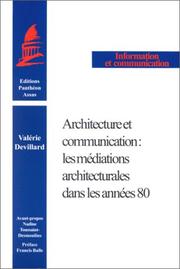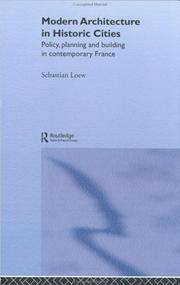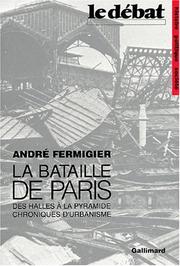| Listing 1 - 10 of 10 |
Sort by
|

ISBN: 2913397166 9782913397163 Year: 2000 Publisher: Paris : Panthéon-Assas : L.G.D.J. diffuseur,
Abstract | Keywords | Export | Availability | Bookmark
 Loading...
Loading...Choose an application
- Reference Manager
- EndNote
- RefWorks (Direct export to RefWorks)
Mass media and architecture --- Architecture and state --- Médias et architecture --- Architecture --- History --- Histoire --- Politique gouvernementale --- Médias et architecture --- Mass media and architecture - France - History - 20th century. --- Architecture and state - France - History - 20th century.
Book
ISBN: 2203231750 9782203231757 Year: 1982 Volume: vol *86 Publisher: Tournai Casterman
Abstract | Keywords | Export | Availability | Bookmark
 Loading...
Loading...Choose an application
- Reference Manager
- EndNote
- RefWorks (Direct export to RefWorks)
Architecture --- Bouwkunst --- France --- Frankrijk --- Sociologie --- Architecte - rôle --- Architecte --- Architecture and state --- Architecture and society --- History --- Parent, Claude --- 20e siècle --- Architecte - image --- Architecte - profession --- Architecte - sociologie de la profession --- Architecture and state - France --- Architecture - France - History - 20th century --- Architecture and society - France
Book
ISBN: 9782862220703 9782862220703 2862220701 Year: 2010 Publisher: Paris: Recherches,
Abstract | Keywords | Export | Availability | Bookmark
 Loading...
Loading...Choose an application
- Reference Manager
- EndNote
- RefWorks (Direct export to RefWorks)
C'est une époque, un style, une histoire. Les années 1980, le postmodernisme architectural, la Gauche au pouvoir. Les Grands Projets et Banlieues 89. Le Syndicat de l'architecture et un mouvement en faveur des Ateliers Publics d'Architecture et d'Urbanisme. Les uns en appelaient déjà à la raison, tandis que les autres exaltaient encore la révolution. Le Mai 81 des architectes aura balancé durant au moins deux années entre l'appel au projet et à la construction au sein d'un exercice libéral canonique, et l'attente inassouvie d'un grand chamboulement de la fabrique de la ville qu'auraient probablement suscité la généralisation d'ateliers publics municipaux rassemblant des architectes fonctionnaires. Faire grève contre les fonctions officielles aura été l'un des privilèges de ceux qui étaient jeunes en mai 68 ; 81 sonnera déjà la redistribution des cartes et des positions. Mais si 68 fut une période de remises en question, Mai 81 ne le fut pas moins. Et nous nous serions trompés à nous être laissés aller à penser que les débats et polémiques de l'époque se seraient éteints pour de bon. Comme un symptôme, tous les lauréats français d'un grand projet mitterrandien se sont trouvés engagés d'une manière ou d'une autre en 2008 dans le Grand Paris de Nicolas Sarkozy. Ce nouvel essai s'inscrit dans le prolongement des Architectes et Mai 68 paru il y a six ans. Il cherche à réactiver et revisiter Mai 81 pour clore peut-être cet entre-deux-Mai qui nous aura tous intensément marqués et aura si profondément redessiné les contours de notre quotidien
Public architecture --- City planning --- Architecture and state --- Architecture --- Architecture publique --- Urbanisme --- History --- Political aspects --- Social aspects --- Histoire --- Aspect politique --- Aspect social --- Politique gouvernementale --- France --- Politics and government --- Politique et gouvernement --- Architecte - histoire de la profession --- Architecte - sociologie de la profession --- Architecture - Political aspects - France --- City planning - Political aspects - France --- Architecture and state - France - History - 20th century

ISBN: 0415154928 9780415154925 Year: 1998 Publisher: London Routledge
Abstract | Keywords | Export | Availability | Bookmark
 Loading...
Loading...Choose an application
- Reference Manager
- EndNote
- RefWorks (Direct export to RefWorks)
Architecture and history --- Architecture and state --- Architecture --- History --- -Architecture and history --- -Architecture and state --- -State and architecture --- History and architecture --- Architecture, Western (Western countries) --- Building design --- Buildings --- Construction --- Western architecture (Western countries) --- Art --- Building --- Design and construction --- State and architecture --- France --- Architecture [Modern ] --- 20th century --- Architecture and history - France. --- Architecture and history - France --- Architecture and state - France --- Architecture - France - History - 20th century

ISBN: 9782070722099 2070722090 Year: 1991 Publisher: Paris Gallimard
Abstract | Keywords | Export | Availability | Bookmark
 Loading...
Loading...Choose an application
- Reference Manager
- EndNote
- RefWorks (Direct export to RefWorks)
Architecture and state --- Urban renewal --- Architecture --- Rénovation urbaine --- History --- Social aspects --- Politique gouvernementale --- Histoire --- Aspect social --- Paris (France) --- Buildings, structures, etc --- Constructions --- City planning - Political aspects - France - Paris - History - 20th century. --- Architecture and state - France - Paris - History - 20th century. --- City planning
Book
ISBN: 9782070323357 2070323358 Year: 1985 Publisher: Paris Gallimard
Abstract | Keywords | Export | Availability | Bookmark
 Loading...
Loading...Choose an application
- Reference Manager
- EndNote
- RefWorks (Direct export to RefWorks)
L"architecture est-elle le fait du prince, le "domaine résevé du pésident de la République? Les "chantiers du président" sont devenus aujourd'hui une singularité nationale, l'enjeu le plus spectaculaire des ambitions politiques et une source renouvelée de polémique sur le bon usage des deniers de l'Etat. Au-delà des passions partisanes, l'auteur étudie l'un après l'autre les grands projets architecturaux du septennat.
Architecture and state --- Architecture --- Politique gouvernementale --- Mitterrand, François, --- Paris (France) --- France --- Buildings, structures, etc. --- Cultural policy. --- Constructions --- Politique culturelle --- Politicien --- Projet d'architecture --- Mitterand, François --- Mitterrand, François, --- 20e siècle --- Paris --- Buildings, structures, etc --- -323 <44> --- 711.4<443.61> --- 725 <443.61> --- State and architecture --- Mitterrand, Francois --- -Views on architecture --- -France --- 323 <44> --- Mitterrand, François --- Architecture and state - France - Paris --- Mitterrand, François, - 1916-1996 --- Paris (France) - Buildings, structures, etc
Book

ISBN: 9782281193930 2281193934 Year: 2008 Volume: 24 Publisher: Paris: Le Moniteur,
Abstract | Keywords | Export | Availability | Bookmark
 Loading...
Loading...Choose an application
- Reference Manager
- EndNote
- RefWorks (Direct export to RefWorks)
On connaissait André Malraux écrivain, sensible à la peinture, à la sculpture, aux arts d'Extrême-Orient ou d'Afrique. Mais il fut également très attentif à la création architecturale française et à la protection du patrimoine. Ministre fondateur des Affaires culturelles sous le général de Gaulle, de 1959 à 1969, il contribua à donner à l'architecture et au patrimoine un élan novateur. Il mit en place les fondements de la protection du patrimoine du XXe siècle, lança l'Inventaire général, la loi sur les secteurs sauvegardés et s'intéressa à la commande publique (les préfectures des nouveaux départements de la couronne parisienne, les maisons de la culture, le projet de musée du Vingtième siècle), nouant au fil des années des rapports admiratifs ou amicaux avec des architectes contemporains : Le Corbusier bien sûr, Wogenscky, Faugeron. Il n'est pas indifférent que cet ouvrage, publié aux éditions Le Moniteur dans la collection Architextes, voit le jour quelques mois après l'ouverture de la Cité de l'Architecture et du Patrimoine, haut lieu de dialogue entre architectes et historiens de l'architecture. Issu des communications présentées lors de la journée d'études organisée par le Comité d'histoire du Ministère de la Culture pour le trentième anniversaire de la mort d'André Malraux, cet ouvrage collectif, grâce à l'apport de recherches récentes et de documents inédits, éclaire la politique de l'architecture et du patrimoine des débuts de la Cinquième République. Le livre est accompagné d'un CD-Rom au format MP3 comportant les enregistrements des deux tables rondes de la journée d'études consacrée à André Malraux et l'architecture du 23 novembre 2006 (2 heures 30 d'écoute) et réunissant de nombreux témoignages sur le rôle de l'écrivain-ministre en matière d'architecture et de patrimoine et le célèbre hommage à Le Corbusier prononcé le 1er septembre 1965. (quatrième de couverture)
Histoire de l'architecture --- Politique culturelle --- Politique de l'architecture --- Protection du patrimoine --- Architecture and state --- Architecture --- Création architecturale --- Patrimoine architectural --- History --- Le Corbusier, Charles-Edouard Jeanneret, --- Malraux, André --- Malraux, André, --- 20e siècle --- France --- Conception architecturale --- Architecture and state - France - History - 20th century --- Architecture - France - History - 20th century --- Le Corbusier, Charles-Edouard Jeanneret, 1887-1965 --- Malraux, André, - 1901-1976 --- Malraux, andré (1901-1976) --- Et l'architecture
Book
ISBN: 9782281193985 2281193985 Year: 2008 Volume: 18 Publisher: Paris : Le Moniteur,
Abstract | Keywords | Export | Availability | Bookmark
 Loading...
Loading...Choose an application
- Reference Manager
- EndNote
- RefWorks (Direct export to RefWorks)
Patrimoine architectural --- Paimpol --- Politique de l'architecture --- Architecture --- Architecture and society --- Architecture and state --- Monuments historiques --- Politique des transports --- Politique du logement --- Politique régionale --- Politique rurale --- Politique urbaine --- Sauvegarde des monuments --- History --- Malraux, André --- Querrien, Max --- Political and social views --- Institut français d'architecture --- Politique - France --- Paris --- Mont-saint-michel --- Protection --- Politique publique --- Querrien, Max, --- Paris (France) --- Protection du patrimoine --- Architecture - France - History - 20th century --- Architecture and society - France --- Architecture and state - France --- Querrien, Max - Political and social views
Book
ISBN: 2842760344 9782842760342 Year: 2000 Publisher: Paris : Séli Arslan,
Abstract | Keywords | Export | Availability | Bookmark
 Loading...
Loading...Choose an application
- Reference Manager
- EndNote
- RefWorks (Direct export to RefWorks)
Public buildings --- Architecture and state --- Buildings --- Government purchasing of real property --- Bâtiments publics --- Architecture --- Construction --- Biens réels --- History --- Remodeling for other use --- Histoire --- Politique gouvernementale --- Reconversion --- Acquisition par l'Administration --- Paris (France) --- Buildings, structures, etc. --- Constructions --- Mansions --- Bâtiments publics --- Biens réels --- Dwellings --- Real property --- State and architecture --- Government purchasing of real property - France - Paris - History - 18th century --- Mansions - France - Paris - History - 18th century --- Architecture and state - France - Paris - History - 18th century --- HOTELS PARTICULIERS --- ARCHITECTURE ET POLITIQUE --- PROPRIETE IMMOBILIERE --- PARIS (FRANCE) --- FRANCE --- 18E SIECLE --- HISTOIRE --- URBANISME
Book
ISBN: 9780816689644 9780816689651 0816689644 0816689652 Year: 2014 Publisher: Minneapolis : University of Minnesota Press
Abstract | Keywords | Export | Availability | Bookmark
 Loading...
Loading...Choose an application
- Reference Manager
- EndNote
- RefWorks (Direct export to RefWorks)
In the three decades following World War II, the French government engaged in one of the twentieth century's greatest social and architectural experiments: transforming a mostly rural country into a modernized urban nation. Through the state-sanctioned construction of mass housing and development of towns on the outskirts of existing cities, a new world materialized where sixty years ago little more than cabbage and cottages existed.Known as the banlieue, the suburban landscapes that make up much of contemporary France are near-opposites of the historic cities they surround. Although these postwar environments of towers, slabs, and megastructures are often seen as a single utopian blueprint gone awry, Kenny Cupers demonstrates that their construction was instead driven by the intense aspirations and anxieties of a broad range of people. Narrating the complex interactions between architects, planners, policy makers, inhabitants, and social scientists, he shows how postwar dwelling was caught between the purview of the welfare state and the rise of mass consumerism.The Social Project unearths three decades of architectural and social experiments centered on the dwelling environment as it became an object of modernization, an everyday site of citizen participation, and a domain of social scientific expertise. Beyond state intervention, it was this new regime of knowledge production that made postwar modernism mainstream. The first comprehensive history of these wide-ranging urban projects, this book reveals how housing in postwar France shaped both contemporary urbanity and modern architecture--
Private houses --- Sociology of environment --- anno 1960-1969 --- anno 1950-1959 --- anno 1970-1979 --- France --- City planning --- Housing --- Architecture and state --- Architecture and society --- Urbanisme --- Logement --- Architecture --- History --- Aspect social --- 72 <44> --- 711.4 <44> --- 711.168 --- 72.036 --- 71.036 --- 711.6 --- 711.16 --- 728.036 --- 351.778.5 --- 316.334.56 --- Frankrijk --- State and architecture --- Architectuur. Bouwkunst--Frankrijk --- Gemeentelijke planologie. Stadsplanning. Stedenbouw--Frankrijk --- Planologie: restauratieplannen; wederopbouwplannen; herbouwplannen --- 20ste eeuw (architectuur) --- Twintigste eeuw (stedenbouw) --- 20ste eeuw (stedenbouw) --- Stadsplanning --- Stadsuitbreiding --- Stadsvernieuwing --- Twintigste eeuw (architectuur) --- 20ste eeuw (woningbouw) --- Huisvestingsbeleid --- Woonbeleid --- Twintigste eeuw (woningbouw) --- Urbane sociologie --- 711.168 Planologie: restauratieplannen; wederopbouwplannen; herbouwplannen --- 711.4 <44> Gemeentelijke planologie. Stadsplanning. Stedenbouw--Frankrijk --- 72 <44> Architectuur. Bouwkunst--Frankrijk --- Reconstruction --- Histoire de l'urbanisme --- Grand ensemble --- Politique publique --- 1945-2000 --- low income housing --- houses --- suburban houses --- City planning - France - History - 20th century --- Housing - France - History - 20th century --- Architecture and state - France - History - 20th century --- Architecture and society - France - History - 20th century
| Listing 1 - 10 of 10 |
Sort by
|

 Search
Search Feedback
Feedback About UniCat
About UniCat  Help
Help News
News